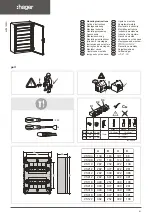
20 / 44
Festo 7DGE_ZR_RFb_en
Note
The longer strand length should preferably be set if possible. A longer freely
oscillating strand length reduces the variation of the measurement results.
The clamp piece (DGE-25 and DGE-40 only) must touch the clamping body.
• Set the distance (L1) between the drive cover and clamp piece (a)/clamping
body (b) (see table).
Type
Distance L1
DGE-25
222 mm/50 mm
1)
DGE-40
222 mm/50 mm
1)
DGE-63
222 mm/50 mm
1)
1)
Alternatives for toothed belt axes with very short stroke.
DGE-25/40
L1
DGE-63
L1
a
b
b
• Direct the acoustic frequency meter towards the centre of the toothed belt
as described in the accompanying operating instructions.
• Make the toothed belt oscillate by striking it with a narrow and heavy ob-
ject, for example an Allen key or pin punch.
Note
The belt must be able to oscillate freely.
To assess the toothed belt pretension, several measurements should be
made to balance out any measurement tolerances.
• Compare the measurement with the specified value (see table).
Type
Frequency (f)
DGE-25
155
+4
Hz/515
+14
Hz
1)
DGE-40
143
+4
Hz/439
+12
Hz
1)
DGE-63
136
+3
Hz/366
+10
Hz
1)
1)
Alternatives for toothed belt axes with very short stroke.
Setting the toothed belt pretension
Warning
The pretension of the toothed belt is not an indicator of wear!
The values specified here are based on a new toothed belt.
The pretension of the toothed belt diminishes during storage and operation.
This is a normal process and not an indication of wear.
Содержание DGE ZR RF Series
Страница 1: ...Repair instructions en Toothed belt axis DGE ZR RF 7DGE_ZR_RFb_en...
Страница 43: ......
Страница 44: ......
Страница 45: ...Operating instructions en Toothed belt pretension test equipment 7Tension01_TBb_en...
















































